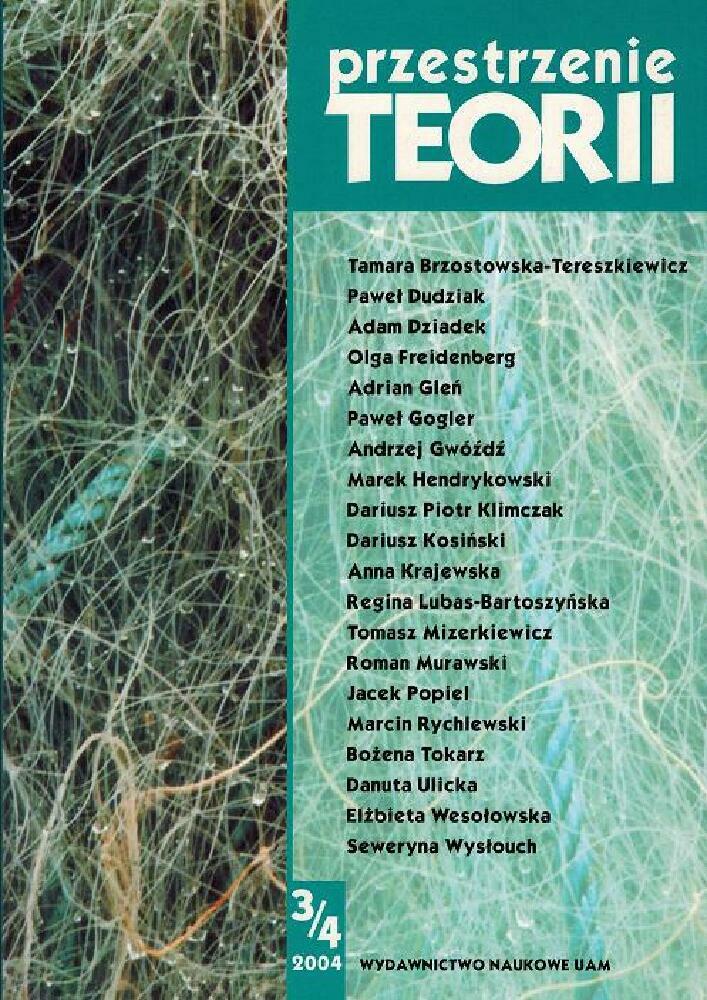Abstrakt
Considering the nature of the relation medium - form the author proposed an insight into two models of relationships between the cinema and the theatre: the first one including the decade of 1925-1935 and the contemporary one. However, the author is not concerned with how the theatre takes advantage of the achievements of the cinema, but he wishes to show the intermedial relationships which join the stage with the screen at the level of the medium - as a vision machine incorporated into a wide system of culture. And this is connected not only with techniques of forming the presented worlds, but first of all with calculating newer and newer environments for technology of the technically mediated seeing. Thus, if intermedia character was formerly expressed in the exchange of forms between the media (film in the theatre/spectacle in film), then the contemporary spaces of the borderline (represented, let's say, through Peter Greenaway's installations) concern tensions between the materiality of the world, medial character of cinema images and mobility of the spectator. Theatre becomes here an element of film culture, and film intervenes in the stage creating spectacles of medial interfaces.Bibliografia
Arnheim R. (1961), Perspektywy telewizji, w: tegoż, Film jako sztuka, przeł. W. Wertenstein, Warszawa.
Brewster B., Jacobs L. (1997), Theatre to Cinema. Stage Pictorialism and the Early Feature Film, Oxford.
Carroll N. (1996), Defining the Moving Image, w: tegoż, Theorizing the Moving Image, Cambridge.
Chyła W. (1987), Spektakl filmowy: fenomen w stadium rozpoznania, w: J. Trzynadlowski (red.), Estetyka i struktura dzieła filmowego, Wrocław („Studia Filmoznawcze” VI).
Comołłi J.-L. (2001), Maszyny widzialnego, przeł. A. Piskorz, A. Gwóźdź, w: A. Gwóźdź (red.), Widzieć - myśleć - być. Technologie mediów, przekł. zbiorowy, Kraków.
Cywjan J. (2001), Rentgen, chirurgia, mikroskop w semiotyce wczesnego kina (Próba postawienia zagadnienia), przeł. B. Żyłko, w: T. Szczepański, B. Żyłko (red.), Cudowny
Kinemo. Rosyjska myśl filmowa, przekł. zbiorowy, Gdańsk.
Elsaesser T. (1998), Raum-Körper. Peter Greenaways Re-Installation des Kinos, in: J. Felix (Hrsg.), Unter die Haut. Signaturen des Selbst im Kino der Körper, St. Augustin.
Elsaesser T. (2002), Filmgeschichte und frühes Kino. Archäologie eines Medienwandels, München.
Garncarz J. (1998), Vom Variete zum Kino. Ein Plädoyer für ein erweitertes Konzept der Intermedialität, in: J. Helbig (Hrsg.) (1998).
Gunning T. (1990), The Cinema of Attraction: Early Film, Its Spectator and the Avant-Garde, in: T. Elsaesser, A. Barker (eds.), Early Cinema: Space - Frame - Narrative,
London.
Gwóźdź A. (2003), Obrazy i rzeczy. Film między mediami, Kraków (wyd. 2 przejrzane i poprawione),
Heider F. (1926), Ding und Medium, „Symposion“, H. 2.
Helbig J. (Hrsg.) (1998), Intermedialität. Theorie und Praxis eines interdisziplinären Forschungsgebiets, Berlin.
Hickethier K. (1996), Am Anfang der Elektrifizierung der Kultur - die ersten Filme und die Idee des Fernsehens, in: H. Segeberg (Hrsg.), Die Mobilisierung des Sehens. Zur Vor- und Frühgeschichte des Films in Literatur und Kunst, München.
Hoormann A. (2003), Lichtspiele. Zur Medienreflexion der Avantgarde in der Weimarer Republik, München.
Ingarden R. (1972), Kilka uwag o sztuce filmowej, w: A. Helman (red.), Estetyka i film, Warszawa.
Jay M. (1999), Nowoczesne władze wzroku, przel. M. Kwiek, w: E. Rewers (red.), Przestrzeń, filozofia i architektura. Osiem rozmów o poznawaniu, produkowaniu i konsumowaniu przestrzeni, Poznań.
Kita B. (2003), Między przestrzeniami. O kulturze nowych mediów, Kraków.
Luhmann N. (1986), Das Medium der Kunst, „Delfin“ VII.
Luhmann N. (1997), Medium und Form, w: tegoż, Die Kunst der Gesellschaft, Frankfurt/ M.
McLuhan M. (1975), Wybór pism. Przekaźniki, czyli przedłużenie człowieka. Galaktyka Gutenberga. Poza punktem zbiegu, wyboru dokonał J. Fuksiewicz, przel. oryginału angielskiego K Jakubowicz, wstępem opatrzył K. T. Toeplitz, Warszawa.
Musser Ch. (1984), Toward a History of Screen Practice, „Quarterly Review of Film Studies” 9, Nr. 1 (Winter).
Paech J. (1997) Paradoxien der Auflösung und Intermedialität, w: M. Wamke, W. Coy, G. Ch. Tholen (Hrsg.), HyperKult. Geschichte, Theorie und Kontext digitaler Medien, Frankfurt/M.-Basel.
Paech J. (1998) Intermedialität. Mediales Differenzial und transformative Figuration, w: J. Helbig (Hrsg.) (1998).
Themerson S. (2002), O potrzebie tworzenia widzeń, w: A. Gwóźdź (red.), Europejskie manifesty kina. Od Matuszewskiego do Dogmy. Antologia, Warszawa.
Virilio P. (1984), Guerre et cinema I. Logistique de la perception, Paris.
Wollen P. (1982), „Ontology” and „Materialism” in Film, w: tegoż, Readings and Writings.
Semiotic Counter-Strategies, London.
Zielinski S. (1989), Audiovisionen. Kino und Fernsehen als Zwischenspiele in der Geschichte, Reinbek bei Hamburg.
Licencja
Autorzy
Autorzy tekstów przyjętych do publikacji w czasopiśmie „Przestrzeniach Teorii” są zobowiązani do wypełnienia, podpisania i odesłania na adres redakcji umowy o udzielenie nieodpłatnej licencji do utworów, z zobowiązaniem do udzielania sublicencji CC.
Zgodnie z umową, autorzy tekstów opublikowanych w czasopiśmie „Przestrzeniach Teorii” udzielają Uniwersytetowi im. Adama Mickiewicza w Poznaniu niewyłącznej i nieodpłatnej licencji oraz zezwalą na użycie sublicencji Creative Commons Attribution-NonCommercial-NoDerivatives 4.0 International (CC BY-NC-ND 4.0).
Autorzy zachowują prawa do dalszego, swobodnego rozporządzania utworem.
Autorzy, którzy wykorzystują w swoim tekście cudze utwory (np. ilustracje, fotografie) proszeni są o dostarczenie do redakcji czasopisma zgodę na publikację od uprawnionych podmiotów.
Użytkownicy
Zainteresowani użytkownicy internetu uprawnieni są do korzystania z utworów opublikowanych po 2015 roku „Przestrzeniach Teorii” tylko w calach niekomercyjnych, pod następującymi warunkami:
- uznanie autorstwa - obowiązek podania wraz z rozpowszechnionym utworem, informacji, o autorstwie, tytule, źródle (odnośniki do oryginalnego utworu, DOI) oraz samej licencji;
- bez tworzenia utworów zależnych - utwór musi być zachowany w oryginalnej postaci, nie można bez zgody twórcy rozpowszechniać np. tłumaczeń, opracowań.
Do wszystkich tekstów opublikowanych przed 2015 r. prawa autorskie są zastrzeżone.
Inne
Uniwersytet im. Adama Mickiewicza w Poznaniu zachowuje prawo do czasopisma jako całości (układ, forma graficzna, tytuł, projekt okładki, logo itp.).
